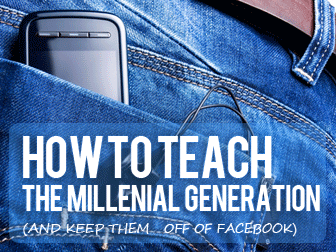Grabbing their Interest and Holding It: Innovative Uses of Technology


However, they are also used to instant gratification, multitasking, and can present some challenges to classroom instruction, such as inattentiveness and overuse of technological devices. Given that a major component of teaching is connecting with learners, what are some methods that teachers can use to connect with the millennial generation and keep their interest?
Alter the Lecture Format
The lecture does not have to be dispensed with completely, and sometimes it is a necessary, efficient, and even powerful method to relate information. But the lecture alone only reaches a select number of students. Instead of just lecturing, make the lecture interactive. Ask students questions or offer examples, and make use of Powerpoint, which students are accustomed to, to support the lecture in the class. It is easy to load slides and text into Powerpoint to create a lecture on the Holocaust, for example. Or give students an outline of the lecture for them to fill in to keep them involved. Finally, make the lecture as short as possible, just enough time to relate the necessary information before moving into a different mode of instruction. The lecture can be a powerful learning tool but should be used judiciously.
Incorporate Visuals
Incorporating visuals will also aid a lecture. Learners respond more to a presentation if it is contextualized. For example, when explaining verb tense, a handout graphically displaying the different tenses is helpful. Or a quick search on YouTube before class can yield some impressive results. For example, if the presentation is about urban decay and pollution, pictures of a major landfill can spark a discussion. Reproductions of famous paintings, such as those by Picasso, can also serve as a starting place for discussion and writing. Finally, having students bring in their own visuals to represent something the class has just read and explain the connection also works well.
Incorporate Group Work
Group work can also be highly successful with Generation Y because they have worked in groups all of their lives. After a brief lecture on a topic such as global warming, move students into groups and have them discuss it and come up with causes and possible solutions. Every member of the group should have a role within that group, such as the researcher to review the text or writer to take notes. There should also be a leader to keep everyone on task. It is also effective to vary the group structure within a class period, going from whole class to small group to pair work instruction.
Teach by Discovery
Another alternative to the lecture format is to teach by discovery. Instead of telling students the information, have them discover it themselves. If students have just read a short story, for example, have them work together to determine the major message or theme of the story, or present them with a dilemma, and have them come up with the solution. Or when introducing a new reading, present students with a series of vocabulary words related to the reading and have them determine what the words have in common and group them accordingly. This will have the additional affect of preparing students for the reading’s topic and vocabulary.
Incorporate Technology –clips, IPODs, blogs, and video games
Students are used to technological devises, so incorporate them in class instruction. This can be as simple as having students type, research, and illustrate their own papers as part of class. Or make use of YouTube’s resources: for example, when teaching an article on the alleged “Stupidity Epidemic” in the U.S., include a clip from YouTube of Jay Leno’s “Jaywalking,” in which he walks the street and asks passersby seemingly easy questions (and doesn’t always get the correct answer): “What color is the White House?” When students are reading a novel, set up a class blog and have students blog about it so that it is an interactive rather than the more traditional and personal journal. If students are text-messaging each other all the time, make that a class assignment. Having students translate text messages into standard or formal English can raise awareness on register differences. Or design a lecture in podcast format, post it on a class website, and have students download and listen to it at home. Some instructors have also used simulations and videogames effectively in their classes. Other instructors have exploited the use of Digital Gaming, interactive games in which students work online, assume a role, and work toward some common goal. Other instructors use social networking sites where students can collaborate on projects. These sites are of particular help to more introverted individuals, who are more likely than extraverts to locate their authentic “selves” in cyberspace
But with careful planning and being flexible, turning Generation Y from passive learners text messaging their friends in the back of the room into active learners is possible.